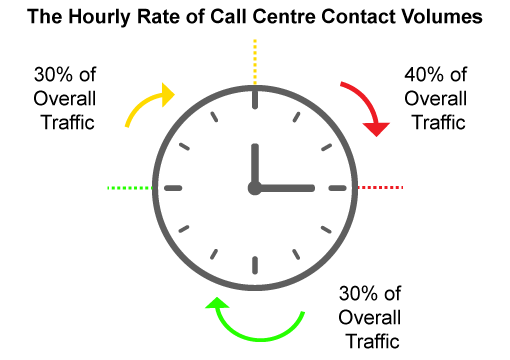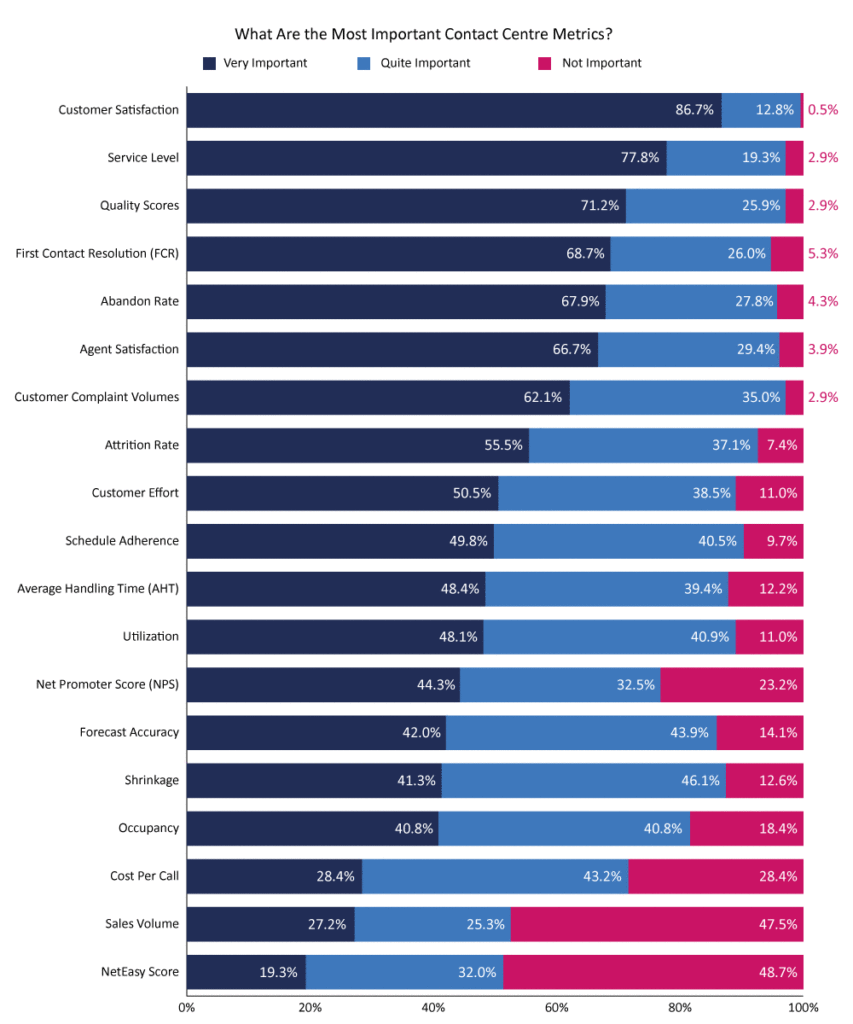Paul Weald answers the question what is a call centre, explains what separates it from the contact centre and notes ten things that are great to know.
What is a Call Centre?
First let’s answer the question ‘what is a call centre?’
A call centre is a department that deals with incoming and outgoing telephone calls. These can be from both new and existing customers and are handled by a team of advisors, otherwise known as agents.
For many companies it is the cornerstone of their Customer Service.
It is traditional for companies of a larger size to have call centres for the purposes of:
- Offering customers support
- Handling their queries
- Carrying out telemarketing
- Conducting market research
However, each of these functions has developed greatly in the past few years, which has led to the emergence of the contact centre.
To find out more about the development of the call centre, read our article: The History of the Call Centre – Updated
What’s the Difference Between Call Centre and Contact Centre?
A call centre differs from a contact centre in that it traditionally only deals with voice calls. As soon as your call centre handles queries from another channel of contact – whether that’s email, live chat, messaging etc. – it becomes the contact centre.
However, while this is technically the case and almost all organisations now handle customer queries over email as well as the phone, the industry is yet to shrug off the call centre label. So the terms “call centre” and “contact centre” are often used interchangeably.

It is not only a choice between call centre and contact centre either, with some organisations using other terms too. These can include the Customer Experience Hub, Customer Care and Global Support.
For more example of names, read our article: What Should You Name Your Call Centre?
The 10 Things to Know About Call Centres
While we have already discussed a number of basics, here are ten things that are really useful to know if you are considering a career in the call centre industry.
1. People Account for Around 70% of Operational Costs
This figure makes people a key asset of an organisation. It is the people in the centre who have the real impact on the customer, even more so than the technology or processes.
Investing in the right people with the right training will provide the right results, but unfortunately many organisations do not view it like that.
Organisations often feel this way due to their view that, with their traditionally high turnover, advisors are not worth investing in. However, one of the key reasons individuals leave is because of lack of training or progression.
Not having the opportunities to progress is because call centre have very flat structures, with far more advisor roles than leader or manager positions.
Having said that, there are a number of other roles within the call centre. While these often require a specific skill, here are a few positions that you might not have heard about:
- Operations Manager
- Resource Planning Manager
- Customer Service Coach
- Quality Analyst
- Human Resources
To find out more about different careers within the call centre, read our article: Typical Roles in a Call Centre
2. People Are Challenging
Where there are large groups of people working together, management becomes trickier and you will get problems. Call centres have a reputation for high turnover and absenteeism.
These challenges make managing the centre especially difficult when you think that the managers have to forecast and plan their resources very tightly against predicted call volumes.
If a centre is under-resourced for any reason, then queues will form, customers will become dissatisfied and advisors will be put under more pressure.
If a centre is under-resourced for any reason, then queues will form, customers will become dissatisfied and advisors will be put under more pressure.
So if you are working for a call centre that you believe to be under-resourced, it is important to know how to deal properly with angry customers.
3. Monday Is Typically the Busiest Day of the Week
We have all had the weekend to sort our bills or decide on that holiday, so now we are back to our normal week, it’s time to pick up the phone and call the call centre. If you need to call a call centre, try to do it on any day but Monday!
Also, Monday contact volumes can be even higher if the call centre is shut at weekends.
This, paired with the fact that contact centres often report absenteeism to be higher on Monday than any other day, can make Monday mornings in the call centre even more challenging.
4. More Customers Call Between 10am and 12pm Than at any Other Time!
Why? Typically because those calling have either got into work and are settled into their day, so will make their personal calls (managers usually go for meetings during this time so it is easier), or they have returned home after doing the school run and are getting on with the things they need to do.
As well as daily patterns, call centres have to be aware of general patterns in contact volumes at an hourly rate as well. In fact, as a lesser known principle is that 40% of the hourly calls are handled within the first 15 minutes of the hour.

This is because, as Dave Appleby says in his article 7 Ways to Improve the Accuracy of Your Contact Centre Forecasts: “It’s human nature to look at the clock and ring in after the clock strikes the hour.”
In the half an hour after this you’ll likely receive just 30% of your hourly calls, while the final 30% will come into the contact centre in the final quarter of an hour. So, the hourly pattern in call volumes will likely look like the below.

Take a look at your numbers in the call centre and you’ll likely see this pattern emerge.
5. Technology Does Not Always Fully Support the Advisor in Doing Their Job
There can be a lot of technology in a call centre, but for a variety of reasons it may not help the advisor to do their job effectively.
Each technology component may be built separately from the others, so, like a cake mixture, when all the ingredients come together it may not be perfect.
The key factor is to understand how the advisor will use the combination of systems to handle the customer enquiry. The easier it is for the advisor, the better the experience for both the advisor and the customer when queries need to be solved.
Fully integrated systems are often key to this, and over a fifth of call centres have now achieved this through using apps instead of hardware, made available through one cloud-based system.
For more on the relationship between advisors and technology, read our article: Give Agents the Right Tools to Do Their Job
6. Advisors Are the Voice and Ears of the Company
Advisors will talk to more customers in a day than most other people in the organisation do in a year. They can tell you what is happening with customers, what is important to them and what competitors may be doing.
The best call centres use their advisors as a means of providing feedback to all parts of an organisation.
With this being the case, one thing to know about call centres is that advisors are an invaluable research tool and can provide a multitude of ideas on how to do things better or what will or will not work.
The best call centres use their advisors as a means of providing feedback to all parts of an organisation, as other departments – such as marketing and the design team – have the potential to source great insights from listening to advisors share customer feedback.
7. The Technologies Call Centres Use
Traditionally, call centres use a few technologies which are fundamental to their function. These include an ACD system, an IVR and headsets.
However, as customer service has grown to be a competitive differentiator between different organisations, more innovative technologies have begun to emerge.
Many of these technologies are designed on the premise on better supporting advisors to improve customer service. These include the knowledge base, smart desktops and screen pops.
Then there are technologies designed to reduce contact volumes to improve efficiency, these include workforce management (WFM) systems, chatbots and process automation.
But that’s not all. With the call centre’s role in the overall customer experience becoming ever greater, there are also technologies like speech analytics, customer feedback solutions and proactive messaging making their way into the industry.
The graph below, taken from our survey ”What Contact Centres Are Doing Right Now (2023 Edition)“, shows the most popular contact centre technology.

8. Team Leaders Drive Business Performance
The team leader role is critical, provided it involves what its name suggests and that is to lead the team of advisors that they are responsible for.
Team leaders should be present with their team in order to provide support and advice throughout their day. They must also be responsible for coaching and developing their team because it will be these advisors who deliver the service.
In terms of driving business value, as Orit Avital described in her article How to Develop Team Leaders in the Contact Centre, team leaders need to be prepared to:
- Have difficult conversations
- Treat each member of the team as an equal
- Create a team feedback loop
- Get to know each of the advisors in their teams personally
In the flat structures of contact centres we often get caught up in the idea of hierarchy. But remember, the key role of a team leader is boosting advisor happiness.
9. How Contact Centres Measure Performance
There are certain metrics that can be used to measure the quality of your call centre function and level of customer service.
Call centre metrics are often broken down into three categories:
Historical
These give an indication of the historical demand of the call centre, which helps the team to better forecast, schedule and plan for the future.
e.g. Number of Calls Handled, Forecast Accuracy and Average Handling Time
Real-Time
These give an insight into the current demand of the call centre, which enables better intraday management to cope with demand.
e.g. Service Level, Wait Time and Advisor Availability
Customer Focused
These give an idea of the effectiveness of the customer–advisor interactions within the call centre, particularly in terms of quality.
e.g. Customer Satisfaction, Quality Scores and First Contact Resolution
If you are wondering what other metrics contact centres use and how important they see them, take a look at the graph below (taken from our survey ”What Contact Centres Are Doing Right Now (2023 Edition)“).

For more on measuring contact centre performance, read our article: The Top 10 Most Important Call Centre Metrics
10. A Call Centre Can Be a Great Place to Work
With a wide range of opportunities to fit many different circumstances, working in a call centre can be great as a first job to provide staff with experience or flexibility in the working hours that are needed to meet family or other commitments.
In addition, with more and more contact centres focusing on the advisor experience, improving culture and adding gamification, there is usually great camaraderie and friendship to be had.
With more and more contact centre focusing on the advisor experience, improving culture and adding gamification, there is usually great camaraderie and friendship to be had.
In Summary
Call centres are a place in which inbound and/or outbound calls are handled by a team of advisors.
They differ from contact centres in that they only receive/make telephone calls, whereas a contact centre would also include other channels of contact – such as email, live chat, social media etc., although the terms are often used interchangeably.

In recent years, call centre trends have included: the emergence of virtual call centres, a growing value in the customer data and the improving technologies that are at the heart of the operation.
But if you’re simply interested in finding out more about call centres, some key takeaways include: Monday is the busiest day of the week, advisors are the voice and ears of the company and, of course, call centres are a great place to work!
Many thanks to Paul Weald for providing much of this information.
To find out more about call centres, try reading any of the following articles:
- What Is Working in a Call Centre Really Like?
- Key Components of a Call Centre Operation
- Introduction to Call Centre Processes
Author: Guest Author
Reviewed by: Robyn Coppell
Published On: 23rd Apr 2019 - Last modified: 5th Feb 2025
Read more about - Call Centre Management, An Introduction to Contact Centres, Attrition, Dave Appleby, Orit Avital, Paul Weald


































